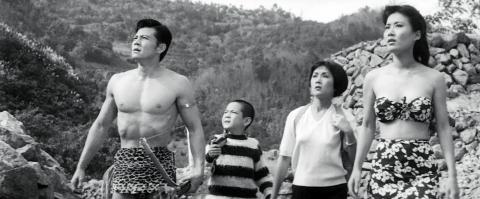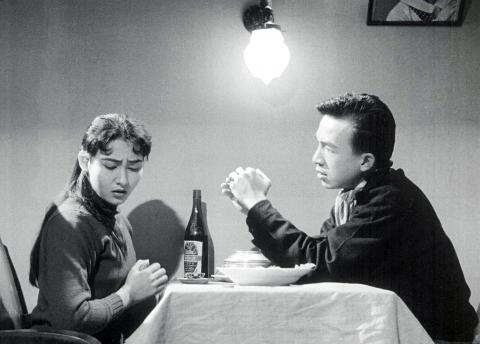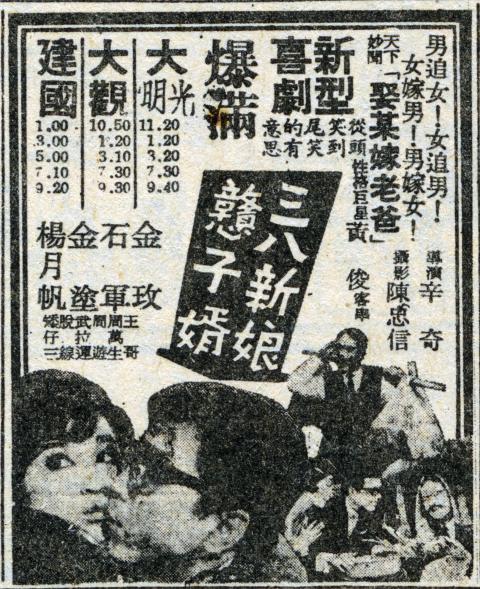When Chris Berry first started watching Hoklo- (also known as Taiwanese) language films in the late 1990s, his Taiwanese friends and colleagues dismissed them as garbage.
“Taiwan’s film world was very much in an art film mindset,” Berry says, referring to the period where New Wave pioneers such as Hou Hsiao-hsien (侯孝賢) and Edward Yang (楊德昌) earned the nation an international arthouse following.
By then, the more than 1,000 crudely-produced and often tawdry Hoklo movies that were pumped out between 1956 and 1981 had largely been forgotten, and it didn’t help that the government strongly supported Mandarin movies and painted Taiwanese culture as vulgar. Only about 200 titles remain today, and the Taiwan Film Institute (國家電影中心, TFI) has been slowly restoring and subtitling them since 2013.

Photo courtesy of Taiwan Film Institute
That year was when Ming-yeh Rawnsley (蔡明燁), a professor at the University of London’s Center of Taiwan Studies, first delved into Hoklo cinema through her research.
“It was very shocking to me, because Hoklo-language films were still around when I was young, but I don’t have any recollection of them. It wasn’t even that long ago,” she says.
Last month, Berry, a film professor at King’s College London and Rawnsley launched the second edition of Taiwan’s Lost Commercial Cinema: Restored and Recovered tour through Europe, which will cover 21 cities by December. Selections include the latest titles restored by the TFI as well as four shorts by modern auteurs that make use of footage from the old films. Their first effort, which began in 2017, was academically-focused, but having established a reputation they are branching out to arthouse theaters and film festivals as well.

Photo courtesy of Taiwan Film Institute
The tour won’t be coming to Taiwan as it is aimed to promote the nation’s culture overseas — but the films are available for viewing at the TFI.
MORE THAN NOSTALGIA
With the bulk of Hoklo cinema’s corpus unavailable when she began her research, Rawnsley says it was like “studying film history without films.” The titles Berry initially found didn’t even have Chinese subtitles, making the task even more difficult.

Photo courtesy of Taiwan Film Institute
Unlike other locales such as the US and Hong Kong where their classic cinema has remained popular and readily available, Taiwan’s old movies are hard to find.
“The interest is more than nostalgia for Taiwanese,” Rawnsley says. “‘It’s rediscovering our past and reconfirming our current identity. It’s very important for cultural preservation to restore these films, but it’s a shame that Taiwanese still don’t have many opportunities to watch them.”
Most of these films were shot on location instead of the studio, and produced outside of the tightly-controlled government system. Although they were also subject to censorship, they provide glimpses into Taiwan’s past that may not be found elsewhere.

Photo courtesy of Taiwan Film Institute
“Almost everything we see now from that era is from the Chinese Nationalist Party (KMT) point of view,” Berry says. “So by intention or by accident, we … get the perspectives on social changes and developments from ordinary people, and … we get to see what ordinary Taiwan looked like then.”
Outside of Taiwan, it was hard to promote these films at first because they are hard to define: “They’re not arthouse films, they’re not like today’s commercial productions, and their ideology is very mainstream — it’s not resistance cinema. It doesn’t really fit what most theaters and film festivals are used to,” Rawnsley says.
But Berry says that changing preferences have contributed to their success.
“It helps that the days when cinephiles were exclusively interested in high art cinema are over,” he says.
LIMITED RESOURCES
Berry proposes Hoklo cinema as an “alternative cinema of poverty,” in the sense that facing budget constraints, the filmmakers engaged in “an exuberant process of borrowing, bricolage and improvisation that drew from other cinemas around the world to produce a distinctly Taiwanese cinematic form.”
Berry adds that the term “poverty” isn’t meant as an insult, but a compliment to Hoklo cinema’s “can-do spirit of improvisation.”
The two Japanese-trained filmmakers featured in this tour, Hsin Chi (辛奇) and Lin Tuan-chiu (林摶秋) both had to make the best of their circumstances, which also included government censorship and pressure from the film companies to succeed in a tight market.
“Their work reflects how filmmakers who lived through the transition from Japanese to KMT rule tried to make a living and pursue their artistic ideals — while maintaining certain control over what they wanted to portray,” Rawnsley says.
Lin, who faced less economic pressure, hoped to improve the production quality of Hoklo cinema while highlighting the struggles of women in a patriarchal society; Hsin was more concerned about quantity but also sought to explore various social issues.
“By focusing on these two fillmakers, TFI is challenging the idea that Taiwanese-language cinema is only a genre cinema, and making us think about its auteur dimensions,” Berry says.
CULTURAL CONTEXT
Since the films don’t fit a definite genre, it’s crucial to present their cultural context through post-screening discussions. Rawnsley and Berry put on over 20 screenings at 10 locations during their first tour, but continued to show the films across Europe on demand until taking a break last May.
Rawnsely was surprised at the richness of the themes that emerged — from the Taiwanese interpretation of gothic horror in Bride in Hell (地獄新娘) to whether the KMT showed any of these films abroad as Cold War propaganda.
Since some of them did fit the Cold War ideology, the fact that the government ignored them led to more discussion on Martial Law-era politics and how it affected the nation’s cultural development.
Rawnsley also noticed that people from different backgrounds interpreted the same events differently — after screening The Fantasy of the Deer Warrior (梅花鹿大俠), a Japanese man saw the wolf scheming to eat the animals as Japan’s historic relationship with Taiwan and China; she saw it as the Chinese Communist Party threatening Taiwan, while a young Taiwanese student said that it was the KMT oppressing Taiwanese.
One genre that global audiences can easily relate to is the melodrama of development, Berry says, referring to the storylines that focus on the risk and rewards of moving from the countryside to the city such as Last Train Out of Kaohsiung (高雄發的尾班車). The pessimism of these plots provides a contrast to the better-known “healthy realism” (健康寫實) productions that the KMT favored as internal propaganda for economic development and social order.
And sometimes, it just took common political circumstances for the audience to connect to the films. Berry noticed the audience growing larger over three screenings in Lithuania, where they “understood the situation of Taiwan almost instinctively.”
“The idea of being a small country with a big brother neighbor that it is not too comfortable with, and also an internally mixed population with different languages, some of whom connect more to that neighbor — the Lithuanians did not need us to explain much about that,” he says.
For more information, visit the project’s Web site: www.taiyupian.uk. TFI’s Web site is: www.tfi.org.tw.

This is the year that the demographic crisis will begin to impact people’s lives. This will create pressures on treatment and hiring of foreigners. Regardless of whatever technological breakthroughs happen, the real value will come from digesting and productively applying existing technologies in new and creative ways. INTRODUCING BASIC SERVICES BREAKDOWNS At some point soon, we will begin to witness a breakdown in basic services. Initially, it will be limited and sporadic, but the frequency and newsworthiness of the incidents will only continue to accelerate dramatically in the coming years. Here in central Taiwan, many basic services are severely understaffed, and

Jan. 5 to Jan. 11 Of the more than 3,000km of sugar railway that once criss-crossed central and southern Taiwan, just 16.1km remain in operation today. By the time Dafydd Fell began photographing the network in earnest in 1994, it was already well past its heyday. The system had been significantly cut back, leaving behind abandoned stations, rusting rolling stock and crumbling facilities. This reduction continued during the five years of his documentation, adding urgency to his task. As passenger services had already ceased by then, Fell had to wait for the sugarcane harvest season each year, which typically ran from

It is a soulful folk song, filled with feeling and history: A love-stricken young man tells God about his hopes and dreams of happiness. Generations of Uighurs, the Turkic ethnic minority in China’s Xinjiang region, have played it at parties and weddings. But today, if they download it, play it or share it online, they risk ending up in prison. Besh pede, a popular Uighur folk ballad, is among dozens of Uighur-language songs that have been deemed “problematic” by Xinjiang authorities, according to a recording of a meeting held by police and other local officials in the historic city of Kashgar in

It’s a good thing that 2025 is over. Yes, I fully expect we will look back on the year with nostalgia, once we have experienced this year and 2027. Traditionally at New Years much discourse is devoted to discussing what happened the previous year. Let’s have a look at what didn’t happen. Many bad things did not happen. The People’s Republic of China (PRC) did not attack Taiwan. We didn’t have a massive, destructive earthquake or drought. We didn’t have a major human pandemic. No widespread unemployment or other destructive social events. Nothing serious was done about Taiwan’s swelling birth rate catastrophe.